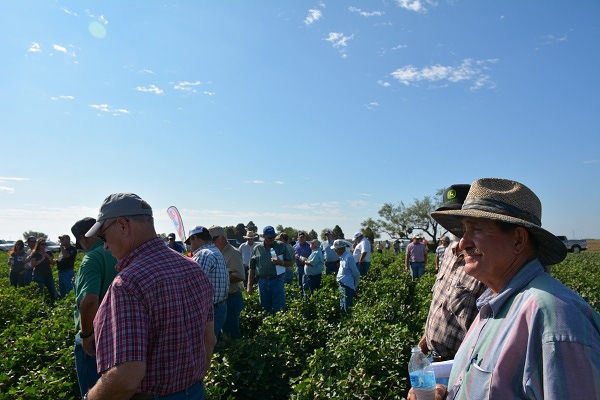
Stress tolerance, improved quality traits and positioning of new dicamba/2,-4-D tolerant cotton varieties dominated discussions during variety trial updates at a recent Tom Green County, Texas, field day — an annual affair for about 15 years on the Wilde farm near San Angelo.
Tom Brooks, a cotton breeder for Americot, said NexGen 1511 B2RF remains “our flagship cotton variety. It’s our biggest selling variety by far, with wide adaptability from south Georgia to Arizona and north to Plainview, Texas. He said 1511 features good quality and good yields.
“We promote it in the High Plains, but it also works well for late planting in the San Angelo area.” It is a later variety, with a smooth leaf and good staple length, and he says, “It’s a good fit in the Southern Rolling Plains.”
For the latest on southwest agriculture, please check out Southwest Farm Press Daily and receive the latest news right to your inbox.
Brad Mund, with Dyna-Gro, says 2285 B2RF is a medium-early, but somewhat indeterminate, variety that fits well in dryland production or with adequate water. “It just keeps going.”
He says 2570 is their flagship variety, which “performs well with good or limited water.” Dyna-Gro expects to have a dicamba and Bollgard III product in 2017.
Gerald Holland says DP 1044 has been a cotton workhorse for Deltapine. “You know what it will do with good or limited water, and it has good heat and drought tolerance.”
He says1410 is an early-range variety, but “farmers can plant late and not give up yield or quality.” DP 1321 “performed well on irrigated and dryland fields. It’s an early-mid variety that will not give up, even if planted a little later.”
2,4-D tolerance
Ralph Porter, with PhytoGen, says deregulation of the Enlist technology in late September paves the way for 2, 4-D tolerant cotton varieties by 2016.
He says 333 WRF is “a game changer in yield.” It’s an early-mid variety that “loads up fruit at the bracts. You don’t need a lot of Pix if 333 is managed well.” He says 339 WRF produces more fruit on the column and “fruits close to the stalk, similar to a stripper variety.”
Porter says 499 WRF was the top-selling variety in the U.S. in 2012 and 2013. “We expect good numbers in 2014, as well. The 495 W3RF variety comes with the same germplasm as 499, but with WideStrike III technology.” He says 333 is a good fit for the San Angelo area.
Stoneville’s ST 4747 was launched in 2014, with limited seed availability, says Clint Warren, with Bayer CropScience. He says 4747 is similar to FiberMax cotton varieties, with a storm-proof boll and early to early-mid maturity. “It was tops in irrigated trials the last two years, but does well on dryland with late planting.”
ST 4946 “does well on light land and with light water. Quality is good, but not as good as FiberMax. We don’t see many varieties in the market now with poor quality characteristics.”
Heat/nematode tolerance
Warren says heat tolerance is built into new varieties, as well as nematode tolerance in some. Heat and drought tolerance will be “promoted in 2015,” he says, and “we will have a good supply.”
FiberMax varieties in the San Angelo trials included FM 1944, a variety that does well “with light water. Quality is similar to 1740.”
He says 2484 is “good under irrigation, and has been the FiberMax No. 1 or No. 2 seller for the last three years. It has good quality and yield.”
New GlyTol TwinLink varieties were released in 2014, Warren notes. This technology offers two Bt genes for protection against worm pests and two herbicide traits for over-the-top applications of either Liberty herbicide or glyphosate, with full commercial tolerance to both herbicides.
An early to early-mid variety, 1830 GLT offers good fiber quality, producing “a lot of big bolls and high yields. It responds well to irrigation.”
FM 2334 GLT is a mid-season variety, with a boll type similar to 2484, and has good fiber quality, Warren says. It also has good Verticillium wilt tolerance, as does 1830.
Not interchangeable
Seed company representatives also cautioned farmers to be aware of the new technologies expected to be available beginning in 2015.
With two new, but different, herbicide-tolerant systems coming within the next two years, farmers must understand that the varieties and chemistries are not interchangeable. One system includes dicamba-tolerant varieties; another includes 2, 4-D tolerance.
Using dicamba on 2, 4-D tolerant cotton will kill it. Applying 2, 4-D on dicamba tolerant cotton will destroy that cotton.
They also cautioned growers to be aware of wind speed, sprayer speed and spray tank clean-out.
“We are excited about the new technology,” Brooks says. “Even if farmers don’t have resistant pigweed, they may have other tough weed species.”
Holland says resistant pigweed has not been a “crucial issue” for San Angelo area farmers — yet. “But it will get here.” He expects XtendFlex technology to be available in some Deltapine varieties for 2015.
About the Author(s)
You May Also Like






